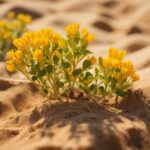[toc]
Introduction
The Chocolate Flower, scientifically known as Berlandiera lyrata, is a visual treat and an olfactory delight. Native to North America, particularly the southwest regions of the United States and Mexico, this daisy-like yellow flower releases a captivating chocolate scent when it blooms. But there’s more to this flower than just its aroma. Let’s delve deeper into the world of the Chocolate Flower and discover its secrets.
- Native Habitat: Southwest United States and Mexico.
- Preferred Environment: Dry sandy loams and rocky limestone soils.
- Special Feature: Releases a chocolate scent when in bloom.
The Allure of the Chocolate Flower
Berlandiera lyrata, commonly called the chocolate flower, lyreleaf greeneyes, or chocolate daisy, is a perennial in dry sandy loams and rocky limestone terrains. This makes it a prime candidate for rock gardens or recreating a native wildflower meadow in your pollinator garden. Once it takes root, it’s known for its drought tolerance and becomes a magnet for bees, butterflies, and hummingbirds.
The plant structure is fascinating. It has numerous short branches at its base, leading to leafless stalks crowned by flower heads. These flowers bloom profusely from late spring until the first hard frost in fall. In milder climates, they can even bloom throughout the year.

Quick Care Guide for Chocolate Flower
- Common Names: Chocolate daisy, chocolate flower, lyre leaf green eyes, green-eyed lyre leaf.
- Scientific Name: Berlandiera lyrata.
- Height & Spread: Ranges between 1-2 feet in height and width.
- Light Requirements: Thrives in full sun to light shade.
- Soil Preference: Prefers average well-drained soils.
- Watering: Known for its drought tolerance.
- Potential Issues: Root rot, but generally has no major pest problems.
Historical Significance and Uses
The Chocolate Flower has more to offer than just its beauty and fragrance. Historically, some Native American cultures in Texas, New Mexico, and the American Southwest used this plant for medicinal purposes. The edible flower petals are said to have a slightly bitter chocolatey flavor. These daisies were consumed to alleviate stomach issues, and their dried roots were burned to inspire courage.
Attracting Pollinators with the Chocolate Flower
One of the primary reasons gardeners are drawn to the Chocolate Flower is its ability to attract pollinators. From bees and butterflies to hummingbirds, these flowers serve as a rich nectar source. Their prolonged blooming season ensures that pollinators have a consistent food source, especially when other flowers might not bloom.
Growing Conditions and Maintenance
Chocolate Flowers are relatively low maintenance. They prefer full sun, although they can tolerate light shade. Ideally, they should be placed in a location that receives 6-8 hours of sunlight daily. While drought-tolerant, it’s essential to water them regularly during their first year of growth. After that, they can thrive with minimal additional watering.
When it comes to soil, the Chocolate Flower isn’t too picky. It can grow in a variety of soil types but prefers well-drained soils. Overwatering or planting them in soil that retains too much moisture can cause the plant to become leggy.
Conclusion
The Chocolate Flower, with its delightful scent and vibrant yellow petals, is a must-have for any garden. Not only does it add a splash of color, but it also attracts a variety of pollinators, making your garden a hub of activity. Whether you’re a seasoned gardener or just starting out, the Chocolate Flower is a low-maintenance, high-reward plant that will bring joy for years.
External Links:
- Epic Gardening’s Comprehensive Guide on Berlandiera Lyrata
- Better Homes & Gardens on Chocolate Flower
- Southwest Gardeners’ Tips on Growing Chocolate Flower
Controlling the Spread of Gooseneck Loosestrife: A Gardener’s Guide
The Battle with Gooseneck Loosestrife
Gooseneck loosestrife, with its tall stems and white, arching flowers, might seem like a dream plant for many gardeners. However, beneath its beautiful exterior lies a potential problem: its invasive nature. Gardeners across the U.S. have been battling this plant’s aggressive spread, seeking ways to control and manage its growth without harming the environment.
Key Insights:
- Rapid Growth: Gooseneck loosestrife can quickly take over garden spaces, crowding out other plants.
- Root System: Its extensive root system makes it challenging to remove entirely.
- Environmental Impact: While it’s not native to the U.S., its impact on local ecosystems is still under study.
- Control Methods: Various methods can help control its spread from manual removal to natural predators.
Understanding the Plant
Gooseneck loosestrife (Lysimachia clethroides) is a perennial plant known for its tall, arching stems and white flowers that resemble a goose’s neck. Originating from Asia, it’s loved by many for its ornamental value. However, its ability to spread rapidly through seeds and its root system has caused concern among gardeners and environmentalists.
The plant thrives in moist, well-draining soils and can often be found near ponds or streams. Its rapid growth rate and resilience make it a formidable opponent in the garden, often outcompeting native plants and altering the local ecosystem.
Methods to Control Gooseneck Loosestrife
Controlling the spread of gooseneck loosestrife requires a combination of manual, chemical, and biological methods. Here are some strategies gardeners can employ:
- Manual Removal: This involves physically pulling out the plant from the ground. Removing as much of the root system as possible is essential to prevent regrowth.
- Mulching: Applying a thick layer of mulch can suppress the growth of new plants and prevent seeds from germinating.
- Chemical Control: While herbicides can be effective, they should be used cautiously to avoid harming non-target plants and the environment. Always follow label instructions and consider consulting with a local nursery or agricultural extension for advice.
- Biological Control: Some insects and animals feed on gooseneck loosestrife, helping control its spread. However, introducing new species to an area can have unintended consequences, so it’s essential to research and consult experts before considering this method.
Learn more about invasive plants and their impact on local ecosystems.
The Importance of Early Intervention
The sooner you can identify and address a gooseneck loosestrife infestation, the easier it will be to manage. Regularly inspecting your garden, especially near water sources, can help you spot this invasive plant before it becomes a significant problem. Collaborating with neighbors and local gardening groups can also be beneficial, as these plants can easily spread from one garden to another.
Conclusion
Gooseneck loosestrife, while beautiful, can pose challenges for gardeners due to its invasive nature. By understanding the plant and employing a combination of control methods, it’s possible to enjoy its beauty without letting it overrun your garden. Knowledge, early intervention, and persistence are key to all gardening challenges.
FAQs:
- What is gooseneck loosestrife?
- Gooseneck loosestrife is a perennial plant known for its white, arching flowers. It’s native to Asia but has become invasive in many parts of the U.S.
- Why is gooseneck loosestrife considered invasive?
- It spreads rapidly, outcompeting native plants and altering local ecosystems. Its extensive root system makes it challenging to remove.
- How can I control the spread of gooseneck loosestrife in my garden?
- Employ a combination of manual removal, mulching, chemical control, and biological methods. Early intervention is crucial.
- Are there any natural predators of gooseneck loosestrife?
- Some insects and animals feed on gooseneck loosestrife. However, introducing new species for control should be done with caution and expert consultation.
- Can I use herbicides to control gooseneck loosestrife?
- While herbicides can be effective, they should be used with caution. Always follow label instructions and consider the environmental impact.
Watch a detailed video on controlling gooseneck loosestrife in gardens.
Remember, while gooseneck loosestrife is a challenge, you can ensure your garden remains a balanced and beautiful space with the right knowledge and tools.


